I’ve been alerted through World Monument Watch in New York about the imminent destruction of Bukit Brown Cemetery, an important heritage site not only for Singapore but with great significance to the history of Penang.
Bukit Brown, named after George Henry Brown whose tomb is now found in the Old Protestant Cemetery of Penang. This cemetery is now a protected Category I Heritage Site within the UNESCO World Heritage Site of George Town.
Under the order the Penang state authorities, archeologists, historians, botanists and conservationists have been looped in to complete a comprehensive heritage management plan to preserve this historic cemetery in entirety. We are also in the process to document the people buried there including the story of George H. Brown.
During a site visit to Bukit Brown Cemetery in September 2013, I’ve discovered tombs which witness the strong family links between Penang and Singapore (e.g. Tan Kheam Hock) and members of Tong Meng Hui who frequented both cities in the early 20th century and these will serve as important clues for the academicians to conduct historical and social researches between Malaya and Singapore in the pre-war years. The obliteration of old tombs and historical sites with a natural setting is a serious mistake in the current age when awareness of heritage preservation is a global trend and every member state in UNESCO including Singapore is vying for World Heritage Listing on one of its sites and trying its best to showcase good examples of conservation efforts.
I’m appealing to the Singapore authorities to be sensitive to the heritage conservation causes, especially to this historic cemetery which is a wealth of knowledge waiting to be tapped by historians from both sides of the Causeway.
Clement Liang
Honorary Scretary
Penang Heritage Trust
26 Lebuh Gereja, 10200 George Town,
Penang, Malaysia
A call was made to the community to provide feedback to the Ministry of National Development (MND), to preserve Bukit Brown as a heritage site for future generations in the draft Master plan 2013. The closing date for feedback is 19th December 2013. For those who don’t know how to begin, there is a template available to guide you here. We encourage you to copy the email to your MP.
To those who have written, We Thank You. Some of you have shared your letters with us. We gratefully reproduce extracts with your kind permission, with the hope it will inspire others to write in and give their feedback.
If you wish to share your feedback with the community, please bcc your letter to MND to a.t.bukitbrown@gmail.com
———————————————————————————————————————————————————–
“We are custodians of our country’s heritage not just for ourselves but for our future generations. It is important that they continue to see for themselves how respect is being shown to our forebears and learn the very real lesson of conserving our roots even, or especially in the face of rapid urban development. Precious “history lesson materials” like Bukit Brown, once lost, may never be recovered. Let no regret come about.”
***
Eugene Tay
“The biggest threat to Singapore is apathy, and when Singaporeans do not feel a sense of belonging and are not bothered with what goes on here, then Singapore is in trouble. For Singapore to survive and prosper in the long term, it is necessary to have more opportunities in preserving our shared memories and creating our shared vision. And preserving Bukit Brown is an excellent opportunity that enables Singaporeans to feel that they belong here by remembering our past and creating our future.
Bukit Brown tells the stories of our forefathers who built Singapore, and creates opportunities for history education and discovery. The cemetery connects Singapore’s past and present, and allows us to understand that Singapore’s success is built up by our forefathers’ sweat and tears, and should not be taken for granted. We should preserve Bukit Brown because it helps us remember our past and keeps us rooted to Singapore.
Bukit Brown presents the opportunity for transforming the cemetery into a world-class living outdoor museum or heritage park. If this transformation adopts a bottom-up approach and with stakeholder engagement, it would allow us to come together, plan and work towards a future Singapore where heritage, nature and our economic needs can co-exist. We should preserve Bukit Brown because it enables us to work together and build bonds and resilience, and to create a space where our children and their children can enjoy and be proud of.
Singapore is a young nation and needs more common spaces like Bukit Brown to remind us how we got here and why this is home, and to create opportunities for building our future social resilience.”
Joyce Chew
“I am a fourth generation Singaporean. My great-grandfather, Chew Boon Lay, was one of Singapore’s very important pioneers.
In April 2012, my parents and I, along with my husband who is English, and our 2 children, discovered where my great-grandfather was buried in Bukit Brown. Thanks to a Straits Times journalist who did a photo-editorial on several important pioneers’ descendants, a photo shoot was conducted at the site of Chew Boon Lay’s tomb.
My parents who had not been to his tomb in more than 20 years came along as well, as did many of my extended family of cousins, uncles, and other relatives. Despite my parents both being aged and not able to walk or see well, they both made the uphill trek to Chew Boon Lay’s tomb in the dark as a huge storm was looming. That was such an important day for them and my family. I was re-acquainted with many relatives and met some whom I had never even met before. We have had several family gatherings since and as such, our April 2012 ‘reunion’ at Chew Boon Lay’s tomb in Bukit Brown served as a very important point of re-connecting with long lost relatives.
My father who is 83 was so elated to have been able to visit his grandfather’s tomb and pay respects to him again after such a long period of time. He was even happier to meet his many nieces, nephews, grand-nieces and grand-nephews, many of whom he had never met before. My siblings live abroad and when they returned to Singapore, I brought them to my great-grandfather’s tomb. All of them were so amazed at how peaceful and beautiful Bukit Brown is, but more importantly they were so happy to be able to visit our great-grandfather’s tomb for the first time.
Having reconnected with my Singapore roots via my great-grandfather’s tomb, I feel so proud to be a 4th generation Singaporean of an important Singapore pioneer who had such humble beginnings and contributed much to Singapore’s growth and prosperity. My children are both Singaporean and English and I want them to grow up feeling connected to Singapore and to be able to trace their roots in Singapore back to my great-grandfather. It was important for me that they visit his tomb and pay respects to their great-great-grandfather and to feel proud to be his descendants. I want them to be able to do this when they are older and when I am no longer around….such a connection in our young country that is forever trying to modernize and improve itself is, for me, one of the most important things if we want our children to have roots in, and feel connected to, Singapore.”
***
Other than the Bukit Timah Nature Reserves, Bukit Brown is a another place where I can bring my families out to Experience nature in a SAFE environment. National Parks are wonderful but they do not give the sense of one totally immersing in Nature.
“We are in a jungle.” my 6 year old boy Isaac said that with excitement when I brought him to the Bukit Brown. We have built too many shopping malls and what values are we cultivating when weekend we see Singaporeans crowding the malls and yet complaining that we are bored to death? Our souls are not fed with Nature but shopping malls and how would that make us as a Nation? We fly out of the country during school holidays to visit other country’s nature while we are destroying one in our own backyard? An article written by a 12 year old lavanyaprakash on Bukit Brown reminded me how important it is to preserve such AUTHENTIC nature and to educate Singaporeans on Nature Outings. I want my children’s generations to be able to experience this Nature and not just Bukit Timah Reserves or other man made National Parks. Thus, not only it is a National Heritage to be preserved, it is a World Heritage to be preserved!”
Other than the Bukit Timah Nature Reserves, Bukit Brown is a another place where I can bring my families out to Experience nature in a SAFE environment. National Parks are wonderful but they do not give the sense of one totally immersing in Nature. “We are in a jungle.” my 6 year old boy Isaac said that with excitement when I brought him to the Bukit Brown. We have built too many shopping malls and what values are we cultivating when weekend we see Singaporeans crowding the malls and yet complaining that we are bored to death? Our souls are not fed with Nature but shopping malls and how would that make us as a Nation? We fly out of the country during school holidays to visit other country’s nature while we are destroying one in our own backyard? An article written by a 12 year old lavanyaprakash on Bukit Brown reminded me how important it is to preserve such AUTHENTIC nature and to educate Singaporeans on Nature Outings. I want my children’s generations to be able to experience this Nature and not just Bukit Timah Reserves or other man made National Parks. Thus, not only it is a National Heritage to be preserved, it is a World Heritage to be preserved!”
***
Ang Hock Chuan
“As recently as September 2011, Bukit Brown was just another cemetery to me. I only remember it as the place I learnt to drive and as the place my grandfather was buried.
My father visited his father’s tomb every Ching Ming till an illness made it difficult for him to walk in that terrain. He had prepared for the eventuality of exhumation and already bought a niche for my grandfather. Unfortunately, I stopped following my father to visit years ago and forgotten where my grandfather was buried.
When my father passed away a few years ago, I became interested to look for my grandfather’s tomb. It would be the last thing I could do for my father to ensure his father’s remains are properly taken care of.
When I heard the news about the proposed highway, there was an urgency to locate my grandfather. I started to search for people who can help me locate him and stumbled on a group of volunteers sharing about Bukit Brown.
My initial interest was to look for my grandfather’s tomb and determine if it would be affected so I can make the necessary arrangements to relocate him.
I joined their guided tours in October 2011. That opened up my eyes to the rich heritage and history contained in Bukit Brown.
Over many visits I was also introduced to the rich bio-diversity and wildlife thriving in this habitat. Whilst I enjoyed listening to the birds in the woods, I was never an avid bird-watcher. But now, I keep a look out for the birds when I am there. I have seen uncommon and endangered species like the Changeable Hawk Eagle, the Red Jungle Fowl, the Greater Coucal and still learning each day about the special flora and fauna of Singapore there.
Bukit Brown turned into a living museum and classroom for me. History came alive. Our cultural heritage is enshrined here. A rich bio-diversity thrives here. It has an aesthetic beauty not found in our man-made parks. I count it my good fortune to have learnt about and visited this wonderful piece of our heritage before any wanton destruction takes place.
For these reasons and more, I hope to see Bukit Brown preserved, for our children’s and grandchildren’s sake. Once lost, lost forever.”
***
Alvin Lee
“We need not look any further than to Bukit Brown when we try to form our Singapore Identity because it is there for all to see. It is a living museum of our rich history that reminds us that our forefathers were migrants from various lands who decided to root themselves here in the Straits Settlement of Singapore, and we are their proud offspring. The fact that Singapore started as a migrant nation also helps us understand and welcome those who come here today, like our forefathers, to seek their fortune and make Singapore their home.”
Arielle Ng Rae
As a local student and youth, I finally took the time out today to join one of the tour groups organised by SOS Bukit Brown today, which I have been wanting to do ever since my ‘A’-levels finished. I was pleasantly surprised with the beauty and heritage of the site, but I was also incredibly saddened. The tour guides were very passionate and knowledgeable about local heritage, and the knowledge I gained today about Singapore and its roots, about how the locals worked together with a myriad of other races to form modern Singapore, about the roots of our unique culture that we often take for granted, made me the proudest of Singapore that I have ever been.
Through the tour, I finally appreciated exactly what it meant to be a melting pot of diverse cultures– how our customs came to be and as a result, how unique we are, and, ironically, the beauty of globalization in contributing to our shared heritage.
I plead with the most earnest and sincere heart, that you will protect Bukit Brown, for the sake of Singaporeans, who are fast becoming disillusioned with this city-state. This tour has done nothing but cement my love for Singapore and my pride for it, and I want many of my peers to feel the same. It is perhaps the natural state of the cemetery, and the untouched beauty of the landscape that lent this genuine connection and pride, but whatever it is, Bukit Brown cemetery has proven to be a beautiful reminder of what it once meant to be Singaporean, and what it could mean for future generations to come.
***
Ian Chong
“Bukit Brown has helped me achieve a better understanding of a history of a part of Singapore’s local history, and has helped me gain a stronger sense of where our nation has come from as a community. It is a reminder of where our society came from and the sacrifices earlier generations made. I hope my children will be able to experience the sheer physicality of our roots, as well as Singapore’s natural heritage. The flooding in Singapore over the past few years, including the Bukit Timah and Thomson areas that are downhill from Bukit Brown, reminds me of the importance of having natural green spaces near already built-up areas.
Moreover, during the periods of heavy haze earlier in 2013, green areas like Bukit Brown were least affected. Singapore needs natural green lungs like Bukit Brown.”
***
Casey Ong
“It is OUR oldest part of history. My grandfather’s grave at Bidadari was long gone more than 10 years ago to clear his “resting place” for more housing developments. Passing by that stretch of road gives us no connection anymore. Even though we have never met our grandfather before, we used to pop by his grave as a kid just to say “hello”, or just to remember how he looked like before by the photo on his grave. We felt the root of our roots. We felt proud of ourselves in some way too because of where we came from. Now I understand why history is such an important part of life.
So, please do not do to the oldest cemetery in Singapore, the Bukit Brown Cemetery what the government had already done at Bidadari. How much more land or our past that you want to “sacrifice” for economic development? Bukit Brown CAN BE an economic source if it can be converted to a tourist area, natural reserve etc. We do not want more roads, please.”
***
Kerry Cracknell
“I am a British citizen who has settled in Singapore with my family and now call it home – and I am proud to do so. My daughter was born here and we are happy here. However, my husband and I are trying to teach our children about the importance of preserving our environment and our natural heritage. We often tell them “once it’s gone, you can’t get it back” and we quote the Native American Cree prophecy “When all the trees have been cut down, when all the animals have been hunted, when all the waters are polluted, when all the air is unsafe to breathe, only then will you discover you cannot eat money”. It is heartbreaking to think that in a few years’ time, such a place as Bukit Brown – with its natural, historical and cultural significance – might be concreted over. Please, please consider saving it for our future generations.”
***
Philip Chai
While I have only set foot on Bukit Brown once, I am fascinated by the deep treasure trove of history it is. It is an unbias holding place of history as alot of our ancestor laid to rest. I remembered when I was young, I have to walk through Choa Chu Kang and there was this cemetery that fascinated me as it has very interesting tombs. I never get around to know it as it made way to development since. It would be a pity if we keep making concession on preservation in the name of progress as that would be a very up-rooting experience. No pictures or archive can replace the actual tombstone and the serenity is irreplaceable.
***
Cathy Tan
“I am the third generation of Kinmenese immigrants. My great grandparents were once buried in Bukit Brown cemetery. My father, Mr Tan Kok Meng 陈国民, had served as board member, treasurer and subsequently as vice chairman of Kim Mui Hoey Kuan 金门会馆 from late 60s to 80s. During that time, he organized many cultural activities and exchanges, including hosting the Asian literary festival. He had also proposed to setup a center to store valuable historical material of Kinmen and their diaspora. The subsequent setting up of the Cultural and Historical Resource Center 新加坡金门会馆文史资料中心 in 2003 and the publication of “I came from Kim Mui” 《我从金门来》in 2006 (which my father was one of the interviewees) were some of the visible fruits.
Now that my father has passed away for four years, I have kept this book close to my heart. My daughter recently used it to write a social science essay about her root. My father, after escaping the turmoil of war had decided to make Singapore his permanent home. Along with many others who came to Singapore between 18th – 20th century, they have contributed to who we are today. Even though we are still a young country, we do have our own history. And the major part of it, is inscribed on the tomb stones in Bukit Brown Cemetery. ”
“My daughter and I visited Bukit Brown and were deeply moved by the heritage and biodiversity of Bukit Brown. Lavanya,who’s my 13 year old daughter wrote about Bukit Brown in her blog here http://mynatureexperiences.
***
Darren Koh
Singapore is not only about concrete buildings and integrated resorts: it has in Bukit Brown a huge repository of stories which when told, make people aware of Singapore as a hub of trade commerce and culture in Asia all this long time ago. It is so much easier to show a human Singapore when you bring back to mind the human stories told every week by the Brownies on their tours – these are stories that make this place, home.
Conservation does not mean no development
One point I wish to stress is that conservation does not mean no development: just as we can develop around an existing building and incorporate its uniqueness into our plans, it should be possible to conserve Bukit Brown without halting development. What is needed is more diverse, out-of-the-box thinking. For instance we will still need parks in Singapore – well, we have one already. While the older generations have reservations about going to a cemetery for a walk, the younger set do not, and Bukit Brown is already being used as one. Why not develop it’s potential? Here is a place where amidst the stones stories of old Singapore lie. The Brownies have bring the stories to life during their tours, which as noted above, have been receiving a lot of tourist publicity through word of mouth and social media. If self-funded volunteers can do so much, how much more can they achieve if they had help?”
“Each time I pay a visit there, it stirs up emotions from a sort of deep-seated ‘spiritual’ wellspring which I did not know I have. A spiritual awakening of sorts. Ironic isn’t it from a burial ground?
Maybe, it’s the tranquil surroundings, the wonderful tales of an almost forgotten past kept alive by the elan of the volunteer guides, or could it be just the spirits of the ancestors channelling….. I would often end up going away asking myself: How is it that we have neglected our past? Why? Who are we as Singaporeans? What keeps us going? What inspires us? Do we have a national soul? Did we start any fire or if there are any embers left? And so on. So here are some of those rambling thoughts…….after my latest ramble over the hills of Bukit Brown.”
The following is a template for making a representation on Bukit Brown in the draft master plan 2013. It outlines the applicable statues, presents the case for preserving Bukit Brown and provides an option for you to pen in your own words, why Bukit Brown is important to you and Singapore.
The closing date is 19 December, 2013. Please do not delay and send it directly to the email of Benny Lim: MND_benny_lim@mnd.gov.sg.
Please bcc your submissions to a.t.bukitbrown@gmail.com if you are agreeable to allow bukitbrown.com to extract personal anecdotes for a separate blog post
More on the master plan and feedback process here
The URA draft master plan website here
========================================================================================
Mr. Benny Lim
Permanent Secretary
Ministry of National Development
Dear Mr. Lim,
I, the undersigned, am writing to make a submission about the recently released URA Draft Master Plan 2013 under rules 5 and 6, Part II of the Planning Act (Chapter 232, Section 10), “Planning (Master Plan) Rules”, “Objections and Representations” and “Approval of Proposal”, which state the following:
Objections and representations
5. Any objection to or representation concerning a proposal for an amendment to the Master Plan shall be in writing and shall be —
(a) submitted to the Permanent Secretary, Ministry of National Development within the period specified under rule 4(a); and
(b) accompanied by a statement of the reasons or explanations therefor.
Approval of proposal
6.
—(1) Except where the Minister is of the opinion that an objection or representation is of a frivolous nature, the Minister shall afford to any person whose objection or representation was received by him within the period specified under rule 4(a) and has not been withdrawn, an opportunity of appearing before and being heard by a person or persons appointed by the Minister for the purpose, or cause a public inquiry to be held in accordance with Part III.
(2) The Minister, after considering —
(a) the proposal for an amendment to the Master Plan;
(b) the Master Plan;
(c) any objection or representation which has been received by him within the period specified under rule 4(a) and which has not been withdrawn; and
(d) in a case where a hearing or public inquiry has been held in accordance with Part III, the findings and conclusions submitted to him in accordance with rule 14, may approve, with such modifications as he may consider necessary, or reject the proposal for the amendment to the Master Plan in whole or in part.
(3) Notwithstanding rule 4, the Minister, if satisfied that a proposal for an amendment to the Master Plan is not material in nature, may approve the proposal without any notice of the proposal being published.
Specifically, I submit my representation concerning the preservation of the Bukit Brown area (which includes Bukit Brown Municipal Cemetery, Lao Sua, Kopi Sua, Seh Ong) for the conservation of Singapore heritage and nature. The Draft Master Plan 2013 indicates that much of Bukit Brown will become a built-up residential area with a dual four-lane carriageway (hereafter, “highway”) passing through. The area marked for residential use in the Draft Master Plan 2013 is different from the previous 2008 Master Plan, and significantly reduces the size of Bukit Brown Cemetery. The highway cutting across Bukit Brown was not in the 2008 Master Plan. The Environmental Impact Assessment for the bridge component of the highway has not been made public for the public to understand the situation and if applicable, take any necessary mitigating actions to their own properties on lower ground than Bukit Brown.
I would like the Ministry of National Development and relevant state agencies to conserve Bukit Brown, given its multi-layered historical significance for our young city-state.
First, it is the final resting place for many of Singapore’s pioneers going back to the nineteenth century. While the cemetery was in operation between 1922 and 1973, the period it covers extends beyond that, as tombs as early as the 1830s have been found there, indicating the earliest pioneers from the time of Sir Stamford Raffles. Therefore, Bukit Brown is an important time capsule of the historical story arc of Singapore as an important maritime node of Southeast Asia to its present day incarnation. The links to other Straits Settlements sites and thriving regional towns make Bukit Brown important not just for Singapore history but underscores the links to our neighbours, all the more important in today’s globalized economic system. It is a story arc that covers practices under imperial China and colonial Southeast Asia right up to independence and recent history. There are tombs with Chinese imperial, Chinese agrarian, Japanese imperial, Roman, Confucian and inventive calendars, and inscriptions in Dutch, Thai, English, Hokkien, Mandarin and Japanese.
A battle was fought there in World War II and according to the second generation tomb keepers, their parents spoke of mass civilian graves. The battle felled English, Australian, Indian and Japanese soldiers as well as local civilians. There are still soldiers missing in action in this battle. Battlefield archaeologist Jon Copper has described Bukit Brown as one of the rare battlefields that remain intact from World War II, as demonstrated by the British and Japanese wartime maps, during the Battle of Adam Park. This is all the more poignant as we soon approach the 70th anniversary of the Liberation of Singapore in 2015.
Malays used to live in the kampungs along Kheam Hock Road and the greater Bukit Brown area on the Police Academy side near Lao Sua. Jon Cooper has uncovered evidence Indian soldiers were massacred along Kheam Hock Road, abutting Bukit Brown and Lao Sua.
Bukit Brown therefore presents itself as a destination for education for local schools and great potential for education tourism for schools overseas keen to study history, society and culture, as well as war histories. (This is already happening.) The artifacts there are unique and not found anywhere else in the world. The potential for tourism is great, including war site tourism, making Bukit Brown unique.
In essence, Bukit Brown has clearly demonstrated multi-cultural, multi-ethnic histories and wartime history intertwined into its seemingly mundane role as a mere cemetery. This gives it unique value that deserves re-consideration under the Masterplan.
Beyond its historical significance, the Bukit Brown area serves as an urban heat sink and refuge for endangered bird species. As a heavily vegetated area, Bukit Brown also mitigates against surface run-off and consequent flooding. Bukit Brown’s flood mitigation function may be especially important given that the 2013 Commission on Drainage Design and Flood Prevention Measures Final Report states that Singapore may be facing increasingly heavy rainfall. I also note that the recently concluded Our Singapore Conversation notes that 62% and 53% of Singaporeans respectively support the protection of green spaces and heritage sites over infrastructure construction. This is a majority of Singaporeans.
Conserving Bukit Brown is also consistent with the current effort to inscribe the Singapore Botanic Garden as a UNESCO World Heritage Site, since the former is listed on the 2014 World Monument Fund Watch List for endangered heritage sites. Many World Monument Fund Watch List sites like Georgetown in Malaysia later became inscribed as UNESCO World Heritage Sites. Protecting Bukit Brown in our Nation’s development plans demonstrates Singapore’s consistency on heritage protection and commitment to the UNESCO Convention, to which Singapore is a signatory. Obvious damage to and destruction of Bukit Brown may stand at odds with efforts to inscribe the Singapore Botanic Gardens as a UNESCO World Heritage Site. Bukit Brown’s proximity to the Singapore Botanic Gardens allows visitors to easily combine their experience of Singapore’s colonial history with a rich understanding of Singapore’s immigrant history.
Notably, Bukit Brown is one of Singapore’s top visitor sites and a Traveler’s Choice Award Winner for 2013 according to TripAdvisor, a respected online tourism portal, despite limited public transportation access and amenities. This is potential that should be looked into seriously.
<Insert any personal anecdotes here on why Bukit Brown should be conserved, or how it has moved you to a deeper understanding of Singapore and your own identity>
I hope you will protect Bukit Brown and Singapore’s historical, cultural, wartime and natural heritage for future generations, and will have an open discussion on how best to protect Bukit Brown and other heritage and nature sites affected by the proposals in the URA Draft Master Plan 2013. National development includes supporting our Nation’s sense of identity and belonging across generations in addition to infrastructure. I look forward to hearing from you. Please feel free to contact me at:
<email; contact number>
Sincerely,
<FULL NAME>
<NRIC>
How you can give feedback on Bukit Brown in the Draft Master Plan 2013
by Ian Chong
I would like to encourage readers who have an interest in protecting Bukit Brown and other parts of Singapore’s natural and cultural heritage to send in your thoughts about the recent draft Land Use Plan to the Urban Redevelopment Authority. Apart from the regular feedback channel on the Land Use Plan site, you can send your feedback directly to the Permanent Secretary of the Ministry of National Development, MND_benny_lim@mnd.gov.sg. Under Singapore’s statutes on the matter, such non-frivolous feedback should receive a due response from the Ministry of National Development.
Basically, when the URA seeks approval of the Minister for National Development to amend the Master Plan, as is the case presently (the previous Master Plan was 2008) it must:
“publish a notice by advertisement of the submission specifying —
(a) a period of not less than 2 weeks within which objections to and representations concerning the proposed amendment may be made; and (b)the place where a certified copy of the proposal is deposited for public inspection during such period”: rule 4.
Anyone who wishes to object to or make representations concerning a proposal to amend the Master Plan may then make a written submission “accompanied by a statement of the reasons or explanations therefor” to the Permanent Secretary of MND within the specified period: rule 5.
Unless the objection or representation “is of a frivolous nature”, the Minister “shall afford to any person whose objection or representation was received by him within the period specified… an opportunity of appearing before and being heard by a person or persons appointed by the Minister for the purpose, or cause a public inquiry to be held…”: rule 6(1).
Even though people making representations cannot insist on a public inquiry – whether an inquiry takes place depends on the Minister. However, given the use of the word “shall”, the language suggests that the Minister cannot refuse the opportunity of being heard. The Minister then has to decide whether the Master Plan should be amended given the objections or representations from a public inquiry: rule 6(2). (Part III of the Rules — rules 10 to 14 — sets out the procedure if there is a public inquiry.
Read the statutes here and here
As many know, the URA recently released a draft Land Use Plan and is inviting members of the public to provide feedback until December 19 this year. After that time, proposals in the plan will become gazetted and part of policy. Included in the draft Land Use Plan are proposals to zone much of Bukit Brown as a residential area, even though there are no further details at present.
Large areas of Bukit Brown are “reserve land” for future development, even if areas of “cemetery” remain on the Land Use Plan. The eight-lane highway that cuts across Bukit Brown is also part of the current plans. Maps released along with the draft Land Use Plan detail these developments.
We experienced how development can affect our daily lives – from flooding and crowding on public transport to the destruction of heritage and nature. This makes it imperative that we, as citizens, let the government agencies that are supposed to represent our interests understand our legitimate concerns. Your response matters and concerns matter whether they are about protecting heritage like Bukit Brown and Jalan Kubor, which is also slated for construction, or redevelopment in your neighbourhood.
(Note: This is a lay person’s perspective, I welcome someone with legal knowledge to correct me.)
Read more by Ian Chong on Bukit Brown, Development and Possibilities for Singapore
The Case for a Bukit Brown (National) Heritage Park
by Chew Kheng Chuan
7 November, 2013.
Sometime ago when I was looking at Google Earth to check out Bukit Brown, I was struck by what a huge green lung it was that was contiguous to the main Water Catchment Area of MacRitchie and Pierce Reservoirs. In that sense the greenery was part of a single “critical mass,” whose significance – ecological and environmental – depended critically on its mass to create the climatic and rainfall needs of Singapore. I felt that taking away this greenery would be a major detraction and subtraction that cannot be replaced by the addition of many other smaller parcels that may add up to the same area if aggregated.
Otherwise I am very sympathetic to the pressures of the planners needing to look to the provision of housing and road requirements of a developing city and nation.
However I feel it is highly regrettable that Bukit Brown Cemetery has to be sacrificed on the altar of development. It will be an irretrievable loss. This is a resting place of the pioneers of our nation and is a cultural and historical heritage that is the physical expression of our sense of origins and identity.
Are there alternatives? This is a serious question that must be considered further and deeper. When Bukit Brown is developed into a future residential estate, the beneficiaries are limited to the fortunate people who will live there, next to the greenery of MacRitchie Reservoir. However it will be lost to the larger public.
Yet if Bukit Brown were to be gazetted as a National Heritage Cemetery Park, and developed as such, keeping all the graves which represent the earliest of burials in Singapore, and are an authentic expression of the anthropological rituals, ceremonies and culture of a people (still alive and active annually every Cheng Beng period), it can benefit all residents of Singapore, and into the future. Let me explain why.
Indeed the National Parks Board can look to developing this into a National Heritage Cemetery Park (or should that be the Bukit Brown Heritage Cemetery National Park?), develop the landscape and plantings, preserving the old trees, and grow new flora. Then it becomes a NEW environmental, recreational, cultural, historical, educational, natural, and yes, economical-tourism resource for all residents in Singapore – citizens, PRs, migrant workers, visitors, tourists, students, nature lovers, birdwatchers, filial descendents who observe the rites and rituals of Cheng Beng
It then becomes a public space rather than a private, historical, forgotten, “under-utilised” cemetery. Perhaps a stronger case can be made that this serves more powerfully the larger public good than the limited number of the lucky few future residents of the new residential estate of Bukit Brown?
An MRT has been planned and will be built for Bukit Brown – indeed, that will not detract from nor be wasted by the new identity and purpose of this National Heritage Park, for all of Singapore will need good transportation access to it to enjoy its benefits. The Bukit Brown MRT in a new status of Bukit Brown will in the longer run better justify its location and existence, bringing a far greater number of commuters to it than that planned for just residents of the area were it to be an exclusive residential district.
I would argue for considering such an alternative future for Bukit Brown to preserve its past of pioneer burials, and enhance its future, even if my ancestors were not buried there. Indeed, as a child I used to accompany my father and relatives every Cheng Beng, but with their passing I have discontinued this ritual for many decades, which explains why my children have never visited the grave of their great-great-grandfather Chew Boon Lay until recently
I asked my children what thoughts they might wish to share. They said:
“Our father told us we are 5th generation Singaporeans, which we think is cool. We wonder how many of our friends have been in Singapore for 5 generations? Our great great grandfather Chew Boon Lay and great grandfather Chew Hock Seng, are both buried at Bukit Brown. We’re kinda sad that when the cemetery is gone they will be just a memory and lost in our future.”
Chew Kheng Chuan is the great grandson of Chew Boon Lay.
by Walter Lim
(Published in Zaobao on 1 November, 2013, translated by Fabian Tee )
Taking a Closer Look at Singaporeans’ “Interest in the Wild (side)”
I refer to the commentary by Mr Goh Choon Kang ( a media professional and a former MP) entitled “Looking from the sidelines at Singaporeans’ interest in the wild side” dated Oct 23, 2o13. In it he posed the question : “why did the dialogue between civilian and government not take place before unilateral action was taken by one party with the expressed hope of opening more channels of communication? Just reflect for a moment, how the official in charge of heritage affairs must be feeling right now.”
This article has created considerable public misconception. The Prime Minister, after all, had on the occasion of the opening of the Heritage Festival 2013 said that:
“The government does not own the Singapore heritage. It does not define the Singapore heritage. Our heritage is a collection of individual memories, woven together into a national story. It is something that belongs to every Singaporean, and which each one of us can contribute to and help to preserve, individually and collectively”. PM Lee.
Therefore, it stands to reason that any civilian initiative to help Singapore preserve its heritage should be a source of comfort for the authorities. Besides, the National Heritage Board’s Alvin Tan is a broad-minded and enlightened official, and not a petty/small-minded individual as implied by Goh.
In Goh’s article entitled “The basis and limits of dialogue”, he stated that “perhaps I lacked culture or cultural depth, but I feel that most Singaporeans are unlikely to bring their old or young to a desolate place in the middle of nowhere during their free time”.
(I agree) Most people are of this (Goh’s ) same mindset – civilians and officials alike, think that way. It was under such dire circumstances that the application to World Monuments Fund was made. Can anyone imagine holding a dialogue under such circumstances? It would have been laughable. Fortunately the unrelenting efforts (of many) have paid off and many parents do bring their children and elderly parents to Bukit Brown. For his sake and society at large, I sincerely hope that Goh will deepen his cultural depth so that more young and old will come to Bukit Brown for leisurely walks.
On the government’s heavy burden of providing for the basic necessities for millions, Goh said that the volunteers are of the opinion that “you (government) can resolve to solve the existing traffic problems, just leave our Bukit Brown alone. For the record, many alternative plans/suggestions were submitted to the government once the road announcements were made. Subsequently there were suggestions to leave the tombstones by the roadside, blending the past with the modern. Recently, we also took part in the exercise to incorporate Biddari’s history into the planning of the new town. These efforts collectively demonstrate that the volunteers are trying to strike a balance between preserving the past and developing the future. Unfortunately, none of our suggestions/feedback for Bukit Brown found fertile ground and they have since fallen by the wayside.
On the other hand, the plan for Lornie Road reflects a lack of foresight and planning. Three years after expanding the number of lanes on Lornie/Adam Roads in 2009, the government now anticipates a reduction in the (Lornie) lanes after the Bukit Brown highway is built. Instead of expending money on the expansion and subsequent shrinking of Lornie Road, why not just build the Bukit Brown highway in the first place? The excitement that followed the government’s undertaking to quicken the pace of housing and transport infrastructural development after the last General Election quickly morphed into a hidden worry. Plans for building Bukit Brown highway were carried out without the benefit of any impact assessment particularly that of a heritage impact assessment in face of a large scale destruction of historic artifacts. In the final analysis, is the Bukit Brown highway really meant for development or is it an unmitigated disaster?
When the plans were announced last year, an estimated 5000 gravestones were to be affected and LTA then reduced that to 3746 due to a change in road plans. Now the official number has been re-estimated at 4153. What is really going on here? Even more worrisome for us is the sense of how heritage preservation is considered in this country. Minister Tan Chuan Jin said in parliament that (the preservation of) material culture including gravestone, carvings and tiles etc are very important. Yet after discussions at the higher level, there has been no concrete plans for a proposed memorial garden for the preservation of gravestones of important personalities. The imminent threat of destruction to thousands of graves has not provoke the local museums or Chinese clan associations to show any interest in preservation whatsoever. Dare I ask , is any government body or department truly satisfied with this (state of affairs) or process?
Leaving aside Goh’s portrayal of the Bukit Brown volunteers as a bunch of “wild enthusiasts”, this unlikely group of individuals who busy themselves over all things related to Bukit Brown, stands in stark contrast with the total lack of interest displayed by the leaders of the Chinese Clan Associations. This lackadaisical attitude even extends to the discovery of the tombstones of founding fathers of their clans.
At a time when the Gan Eng Seng alumni paid their respects to his grave during Qing Ming, the Chinese High and Nanyang Girls High and Industry Commerce Schools etc have instead chosen to forget their history.
When a country’s polity has no regard for our collective history and the hallowed grounds of our Chinese pioneers and civilisation, evoke nothing but disdain, are policies to blame and have the people all forgotten (the past)?
As Bukit Brown is doomed to its fate, a group of volunteers -whose ranks comprises Indian, Dutch and Japanese and others who know not a single Chinese character – are picking up the Chinese language to decipher tomb inscriptions, studying the various pioneers’ connections with old temples, clan associations, schools and some even extending their research into local history and the Chinese civilization. This abiding interest of the so called “wild enthusiast” calls for a deeper sense of reflection. Surely, this phenomenon is hardly one that can be understood by anyone looking from the sidelines.
More on the road expansion at Lornie Road here.
The full report in Chinese:
正视新加坡人的“野趣”
观点碰撞
吴俊刚先生在10月23日“侧观新加坡人的野趣”中说:“为什么
李总理在文化遗产节时说:“文化遗产并不专属政府,更不能由政府
吴先生曾在“协商的基础和限度”这篇文章就这么说:“也许我缺乏
武吉布朗就是在这种凄风苦雨的情况下,提出申请世界历史遗址,别
政府有为数百万公民解决衣食住行的重任,吴先生更说:“你可以设
反观罗尼路是未曾深思熟虑的工程,2009年扩建后通车三年,就
去年估计5000坟墓受影响,陆管局强调因修改道路设计而减少到
姑且不论武吉布朗学会为何成为吴先生笔下的“野趣”组织,倒是日
为政不思追慎远,一堆黄土惹人嫌,是政府的政策妨碍华社追慎远,
林志强
作者是文史工作者和武吉布朗华语导游
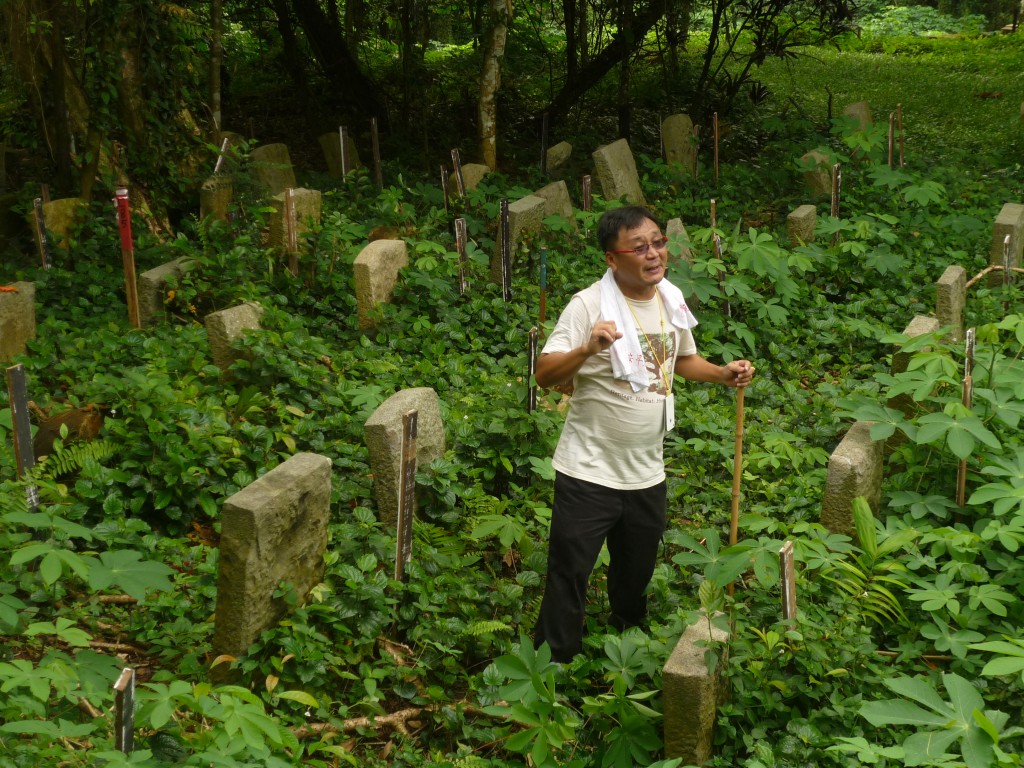
Cluster of Qing Tombs circa 1830s resited twice before Bukit Brown – now staked for exhumation to make way for 8 lane highway (photo Catherine Lim)
A Question of Public Value : Bukit Brown
by Z’ming Cik
(14 October 2013)
It has been a sweet triumph of sorts for the heritage enthusiasts of Bukit Brown who dub themselves the ‘Brownies’. They have now managed to earn international recognition for the site by placing it on the 2014 World Monuments Watch – even if that does not seem likely to change the government’s immediate plans to build a highway cutting through it.
It is not just an affirmation of its significance that Bukit Brown has been selected, alongside Venice in Italy, Yangon historic city centre in Myanmar and sites in war-torn Syria such as a 17th-century souk in Aleppo, as one of 67 cultural heritage sites currently “at risk from the forces of nature and the impact of social, political and economic change” – in the words of the New York-based World Monuments Fund.
It is also an affirmation of a universalistic ethos that any cultural heritage of the world can transcend the narrow confines of ethnic identities, and be protected by all mankind, against irreplaceable loss due to unchecked urban development or other factors. Such is indeed also the true spirit behind the 1972 UNESCO World Heritage Convention, best known for the mechanism of the world heritage list, on which Singapore is attempting to inscribe its Botanic Gardens.
The purpose of this little article here is not to make a case for the nomination of Bukit Brown as a world heritage site – though that can definitely make a fruitful exercise, given its historical and aesthetic values based on all the knowledge accumulated. Instead, I would like to approach the issue of Bukit Brown from a more general perspective, of what is stake in general with plans to sacrifice such a site for traffic and future residential use, and how decisions should be arrived at from the perspective of public administration. For as the Brownies have expressed at a press conference last week, there is an urgent need to ‘reframe’ public discussion, away from a false dichotomy that treats it as a choice between space for the dead and space for the living.
Indeed, the issue of Bukit Brown is not a dilemma between past and future, tradition and modernity, heritage and progress, or community and nation. It may be framed instead as a question of ‘public value’ for the average Singapore citizen, whereby one should weigh between the gains of constructing a highway to ease traffic (and allowing more cars on the road) and the environmental costs which may impact on the quality of life for all residents, not to mention the opportunity costs in compromising a heritage site with value in education and tourism use.
I am borrowing the term ‘public value’ here from Mark H. Moore, Kennedy School of Government, Harvard University, author of the book Creating Public Value. Under such a framework of public administration, one may discuss whether a public enterprise reflects the desires or aspirations of the citizens, and also analyse whether it is cost-effective for collective interests.
This gives us a clearer picture of the problem when we consider the following points. First, in terms of desires or aspirations, 54% of Singaporeans according to the recent Our Singapore Conversation Survey have expressed a preference for preservation of heritage spaces over infrastructure, and 62% have expressed a preference for preservation of green spaces over infrastructure. The Singapore Heritage Society also cites an earlier Heritage Awareness Survey whereby 90% of Singaporeans agree that preservation of heritage would become more important as Singapore becomes a global city.
Second, plans for the 8-lane highway through Bukit Brown were announced without full disclosure of its Environmental Impact Assessment, which should rightly be of public interest. Nature Society has cited the importance of Bukit Brown as a green lung with cooling effects on the climate and mitigating effects against flash floods. We have surely seen how Urban Heat Island (UHI) effects, due to increased urban surfaces and industrial and car emissions, lead to more flash floods. The National Environment Agency is now advising Singaporeans to brace for warmer and wetter days in the next century. Should Singaporeans be inspired then to make extra more babies? Would more population growth and urban development be sustainable in the long run?
The idea of ‘sustainability’ is incidentally concerned not only with economic development but also with environment and social equity; it begs us to rationalise the needs of the present generation, in order not to compromise the ability of future generations to meet their own needs. So who are we to decide for the future generations that they have no need for natural green spaces, for authentic cultural and natural heritage?
Third, an 8-lane highway may be cost-effective for the operations of LTA and its contractors, but is it ‘cost-effective’ for all Singaporeans? On the concern of infrastructure alone, will the benefits be well distributed among Singaporeans? I believe a lot of Singaporeans would prefer to see improvements in public transport – whereby they should be managed as public enterprises rather than as profit-making private enterprises, while controlling the growth or inflow of population meantime. COEs this month have just reached 90K, and ERP rates have been rising too, so how does a new highway represent the interest of the average Singaporean? Should the dictum of the government be what former head of Civil Service, Ngiam Tong Dow recalls: “What’s wrong with collecting more money?”?
An 8-lane highway may make good business sense if the objective is to attract higher demands for car traffic. But it is a road of no return where environmental costs and the loss in heritage are concerned.
Perhaps the word ‘heritage’ is not always useful here, for some people may mistake it as being synonymous with ‘tradition’, and they assume that to acknowledge a cemetery dating back to the Qing dynasty as heritage would mean having to wear a pigtail, or to bow before the image of some dead old merchants and ask for 4D numbers. They imagine ‘heritage’ as a form of liability, instead of as a form of resource for an authentic experience of national history, or of works of art.
How the historical significance of Bukit Brown as ‘heritage’ should be interpreted, is certainly open to debates. But being ‘modern’ does not mean discarding everything of the past. We are not living in an era of Cultural Revolution somewhere in China. The National Heritage Board has also recognised the importance of Bukit Brown Cemetery and the need to work with the community for its preservation.
Being ‘modern’ also means being able to rationalise how one should help steer the development of one’s country or the world at large. Hopefully more Singaporeans will be able to look at the issue of Bukit Brown not as a matter of whether one has personal affinity to it, but from a perspective of public value.
We may ask ourselves: What heritage values does it hold on a local level and on a global level, and how would that represent the desires and aspirations of Singaporeans? In what circumstances would redevelopment be justifiable, and in what way would that represent social equity and long-term interests among Singaporeans?
We as Singaporeans need to rethink what this land of Singapore means to us, and what the word ‘progress’ truly means.
Z’ming Cik is pursuing his Phd in heritage studies in Germany.
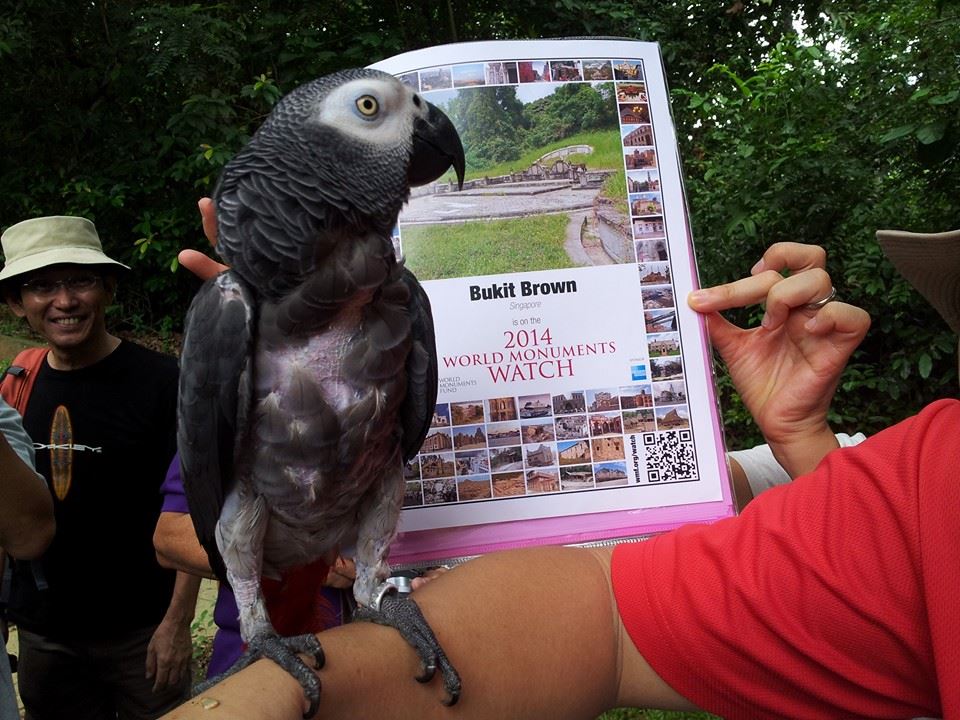
The first tour after the announcement of Bukit Brown’s World Monuments Listing. Basil the macaw weighs in on what it means (photo Khoo Ee Hoon)
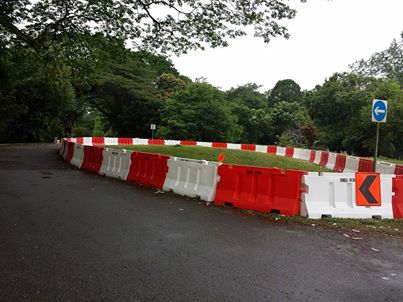
A day after the meet the media session with Brownies on the World Monuments Watch listing, the barricades are up at the roundabout (photo Milli Phuah)
SINGAPORE HERITAGE SOCIETY’S STATEMENT ON LISTING OF BUKIT BROWN ON 2014 WORLD MONUMENTS WATCH
10 October 2013
The Singapore Heritage Society is heartened that Bukit Brown has been included in the World Monuments Watch list for 2014.
Founded in 1965, the World Monuments Fund, which runs World Monuments Watch, is based in New York and is the world’s leading independent organization dedicated to saving mankind’s treasured places. Its expertise and resources, including support from UNESCO, have helped restore some 600 sites in more than 90 countries.
On this year’s Watch List is also Pokfolum Village in Hong Kong, while other sites listed in previous years include the Buddhist Remains of Bamiyan (destroyed by Taliban in 2001), the historic Gingerbread Neighborhood of Port-au-Prince, Haiti (damaged by earthquake), the Cultural Heritage Sites of Syria (destroyed or damaged in the civil war) and Penang’s Georgetown Historic Enclave (2000 and 2002 Watch List) which is now a UNESCO World Heritage site.
This is the first time a Singapore site has been included in the World Monuments Watch. Together with the Singapore Botanic Gardens’ UNESCO nomination, Bukit Brown’s inclusion represents widespread international recognition of the historical importance of local heritage sites. Indeed, Bukit Brown’s narrative of early immigrants and regional histories complements the Botanic Garden’s narrative of colonial empire to provide a more complex and complete story of Singapore.
The nomination of Bukit Brown for World Monuments Watch inclusion was advanced by the community group, All Things Bukit Brown. This has been a grassroots initiative in response to Prime Minister Lee’s National Day Rally call to Singaporeans to step forth to make Singapore a better home for ourselves.
It is also in keeping with independent surveys on heritage awareness in Singapore. The 2006 Heritage Awareness Survey revealed that almost all Singaporeans surveyed (98.4%) felt that heritage plays a positive role in their lives and that an overwhelming 90% agreed that preserving our heritage would become more important as Singapore moves towards becoming a global city.[1] The survey also revealed that 87% of Singaporeans agreed that a better understanding of Singapore’s history and heritage would increase their own sense of belonging to Singapore. Meanwhile the 2013 Our Singapore Conversation survey showed that Singaporeans wanted heritage spaces to be preserved as far as possible.[2]
This World Monuments Watch inclusion is not a one-off event but part of an on-going series of Bukit Brown-related events such as symposiums, exhibitions and public talks that have been organised by citizens and community groups that have been taking place since November 2011.
Finally, the inclusion in the World Monuments Watch 2014 list is in keeping with the Singapore Heritage Society’s call for Bukit Brown to be gazetted as a heritage site. This inclusion should be seized as the opportunity to raise greater awareness of Bukit Brown and to conduct comprehensive documentation of the greater Bukit Brown space that includes the Seh Ong, Kopi Sua and Lau Sua cemeteries, which will provide the basis for future preservation plans.
[1] Channel News Asia (18 July 2007) Heritage awareness rising among Singaporeans: study; see also http://www.heritagefest.org.sg/2007/official/images/stories/Downloads/press_release_shf2007_opening_ceremony.pdf (accessed 8 Oct 2013)
[2] https://www.oursgconversation.sg/wp-content/uploads/2013/08/OSC-Survey.pdf (accessed 8 Oct 2013)
Bukit Brown, Development and Possibilities for Singapore
By Ian Chong
Recent events and public discussions about public transport, the environment, and heritage should give pause to the proposed construction of the dual four-lane carriageway across Bukit Brown. Singaporeans have one last opportunity to consider the consequences of irrevocably altering the face of an important part of our nation’s natural and cultural landscape before the planned exhumations begin in October 2013. Surveys for Our Singapore Conversation indicate that 62 percent of Singaporeans prefer preserving green spaces over constructing roads and other infrastructure, while 53 percent prefer heritage preservation over infrastructure building. (OSC Survey, p. 6) Staying road construction over Bukit Brown demonstrates responsiveness to public needs.
Simply building roads, such as one over Bukit Brown, does not address the fundamental reason underlying congestion in Singapore. As Kishore Mahbubani, dean of the Lee Kuan Yew School of Public Policy, pointed out, the fundamental challenge facing road space in Singapore is sub-optimal public transport, which heightens demand for car use. (ST, Sep 14) Recent steps by the LTA to raise ERP rates and introduce new considerations for the COE underscore the fact that controlling vehicle population should be key to addressing the traffic snarling our roads. The heavy traffic on Lornie Road during rush hours comes from vehicles filtering on and off a congested PIE, an issue a road through Bukit Brown is unlikely to solve. In fact, Singapore can probably never build enough roads if current approaches to car use and public transport are not thoroughly re-thought.
Prime Minister Lee Hsien Loong’s last National Day Rally should provide more impetus for maintaining Bukit Brown in its current form. According to Mr. Lee, new plans to develop Singapore’s southern and eastern coasts along with Paya Lebar mean that, “we do not have to worry about running out of space or possibilities for Singapore. We are not at the limit, the sky is the limit! We are creating possibilities for the future.” This means that there is space for Bukit Brown in its current form in our future and those of our children.
As physical changes in Singapore become ever more prevalent, the remaining tangible markers of our unique heritage and history only grow in importance to society. This is a reality that digitisation can never fully replace or replicate.
In fact, the Prime Minister’s National Day Rally statement about being able to maintain possibilities for Singapore stands in stark contrast to National Development Minister Khaw Boon Wan’s claim that it is necessary to sacrifice Bukit Brown and nature for construction. (Zaobao, Sept. 28) Today’s Singapore is no longer in the 1960s where infrastructure development was imperative.
The haste to construct the dual four-lane carriageway – and other follow-on developments – over Bukit Brown may even be counter-productive. Flooding earlier this month serves as a reminder of the need for development projects to proceed with caution. As the NEA subsequently stated, “Rapid development and urbanisation…are likely to be significant factors which may explain this trend [of heavy precipitation leading to flooding].” (Today, Sept 13) The Expert Panel on Drainage Design and Flood Prevention Measures likewise noted, “increased urbanisation in the Stamford Canal Catchment might have been a contributing factor to the 2010 and 2011 floods…” (p. 13)
Moreover, the panel observed that “other than generating higher and faster surface run-off, increased urbanization may also bring about other impacts such as increased heat production, changes in rainfall patterns and other climate change impacts…” (p. 13) Panel recommendations to mitigate the effects of urbanisation is recognition of the relationship between rapid, large-scale development and flooding. (p.1, 9, 15, 52, 55) Notably, the Environmental Impact Assessment for the road across Bukit Brown remains unavailable for public access.
Building the road over Bukit Brown may prove to be a temporary patch rather a real solution to the challenges of congestion, and can potentially create more difficulties down the line. The LTA and URA should hold off construction until there are more comprehensive ad appropriate ways to address the environmental, heritage, traffic, and development issues that intersect at Bukit Brown.
At a minimum, there ought to be a rigorous, publicly available study first. This is a first step toward finding a more comprehensive and sustainable approach to the issues above. Halting construction clearly comes with costs, but these may be much lower that those from building the road. Singapore is worth the extra effort.
Ian Chong works at a tertiary institution. His comments are in his personal capacity. An edited version of this commentary first appeared online in Today 30 September 2013
by A.J Leow
My trips to Bukit Brown Cemetry tend to stir up some deep-seated emotions within me. My first, which followed a trip to Gardens by the Bay, had evoked images of contrast. On one hand, there is this rich but neglected repository of our cultural and natural heritage amid the lush, unkempt undergrowth and the other, an artificial construct or what I would often refer to as a huge manicured bonsai.
At the Gardens, you put on a headset; pressed some buttons to listen to a disembodied voice on a guided tour. It’s like calling your bank to cancel the annual credit card charge. Quite impersonal. At Bukit Brown, there are no ticket queues, entry fees or closing hours. You get to pepper some guy – in a sweat-soaked T-shirt with a towel around the neck – with questions about our forgotten past.
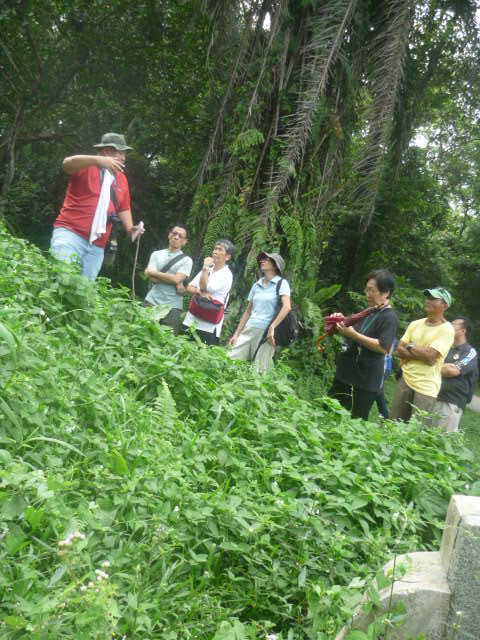
Uphill is a breeze with Brownie Peter Pak telling stories of our forgotten pioneers (photo Catherine Lim)
The bonus is that you may be invited to join the Brownies at a zhi char place after the tour for a get-together makan. How much more Singaporean can you get!
My latest trip came about on National Day 2013 which was followed by a family viewing of the annual parade and the fly-past. While the vignettes of our forefathers by the guides at Bukit Brown – especially that of how they arrived by sea and spied the shimmering lights of the harbour of 星汌 (Isle of Stars) which must have lifted their hopes of a better tomorrow – touched many a chord; the vain exhortations by the emcees at the waterfront parade to portray the Merlion as a national symbol fell really flat, especially when the mythical creature wasn’t sure if it was a lion or a transgendered mermaid. To me, it was an apt metaphor of our confused national identity.
Not so the narrative of Bukit Brown.
At the official parade, there was an actress masquerading as a samsui woman. As a young boy heading off to school, I have seen scores of these weathered-beaten, hardy red-hat women from southern China squatting and lining the roadside, some of them holding rolled-up cigarettes with their calloused hands in the early hours of dawn at Redhill Road. I can assure you, none of them look like the ruddy faced actress on the national stage!
The contrast could not be more stark. Listening to the story-tellers at Bukit Brown to me would be akin to reading a rich body of literary work by local author Catherine Lim, or the playwright Kuo Pao Kun. Bukit Brown is our history; while some of the NDP performances came across like a fleeting piece of newspaper ad or TV commercial. Not quite authentic.
The next day, I picked up a copy of The New Paper to read its coverage of the Brownies’ tribute to our country’s early pioneers. On the following page was a piece on the make-up of the hardcore Singaporean. There were the usual comments about the use of Singlish, the tendency to gripe; pressing lift buttons repeatedly and oh dear, even ‘common resentment towards foreigners.’ The MP for Marine Parade GRC, Tin Pei Ling, mentioned the love for chicken rice, our hardworking nature and the willingness to stay and defend the country during a crisis. Except for the first item, I wouldn’t call that a uniquely Singapore trait.
There was little mention about our heritage and our forefathers who helped build the place we now call home. On an existentialist level, they seem to be no longer part of the wellspring of our national consciousness – the collective National Soul. Are we in danger of becoming the equivalent in Plato’s Cave, bereft of our true identity, which seems to have been reduced to the image of a buffet of laksa, char kuay teow and other hawker’s fare, and a limited lexicon of words such as ‘kiasu’, ‘chope’ and ‘shiok’? Surely, being Singaporean is more that that!
It’s unfortunate that for most of us (that includes me); the history of Singapore has been largely bracketed by or reduced to the two Rs – Raffles and the founding of our Republic. The first is a man in white; or rather a statue in marble white next to the Singapore River, whom most of us don’t really know much about except that his name has been hijacked for a hotel, school, business hub, shopping mall among others, including Singapore Airline’s business class. The second R would be the story of the Men in White, which I bet many of the younger generation would be clueless of who they are or were, with perhaps the exception of our elderly statesman, Lee Kuan Yew.
There’s a yawning chasm in between the two Rs. We need to fill them with what would be the equivalents of our own versions of Benjamin Franklin, Rockeller, Carnegie, and Edison in the largely blank pages of our own history. Names like Tan Ean Kiam (banker and philanthropist), Lim Kim Seng (Justice of the Peace and Teochew leader) and Tan Kim Ching (Kapitan Cina and diplomatic consul to Siam, China and Russia) and bring them back into our national consciousness and collective memory. Make it kind of a Lazarus Project with a uniquely Singapore theme.
That’s why I feel strongly that Bukit Brown Cemetery is a heritage landmark worth saving for the sake of all Singaporeans – now and the future. It’s where the national soul resides. It’s a living museum with names that most Singaporeans can readily identify with, such as the bus routes we take to work (Jalan Boon Lay); MRT stations (Boon Keng); schools we go to (Gan Eng Seng) and makan places (Joo Chiat Place), to name just but a few. There are more than 40 names of streets and places which can be traced back to Bukit Brown.
What’s more, I can imagine their descendants mingling among us – cheek-to-jowl in the MRT and buses; in the queues at NTUC supermarkets; for Toto and 4-D tickets and the char kuay teow stall at Hong Lim complex.
Our forefathers came from afar across the seas – many as coolies including my own grandfather – and caught a glimpse of 星汌 and like the biblical story of Abraham, their descendants have multiplied like the ‘stars’ they imagine to be the bright lights of the future. They chose to come, live, die and be buried here. We owe our presence to them. We need to remember and honour them. The story of Singapore is built on the backs of immigrants, and we should keep on telling their stories unceasingly. More will come because of they have built, what we will build on the foundations they laid. Those newcomers too will catch a glimpse of the shimmering lights of 星汌 (Isle of Stars) when their planes fly over Changi International Airport. Majullah Singapore!
Bio: A.J. Leow is the grandson of a coolie who has brought his children to Bukit Brown several times to understand their roots. His family celebrated National Day at Bukit Brown this year.
Related:
History of the Dead, Heritage of the Living
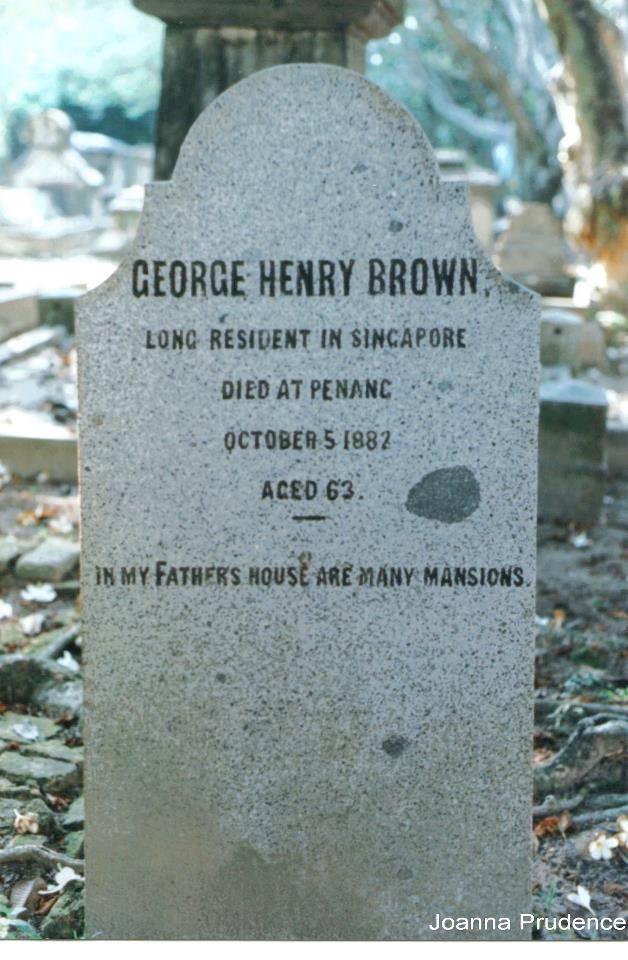

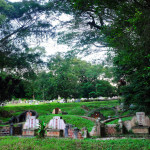


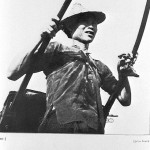

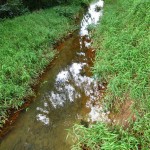




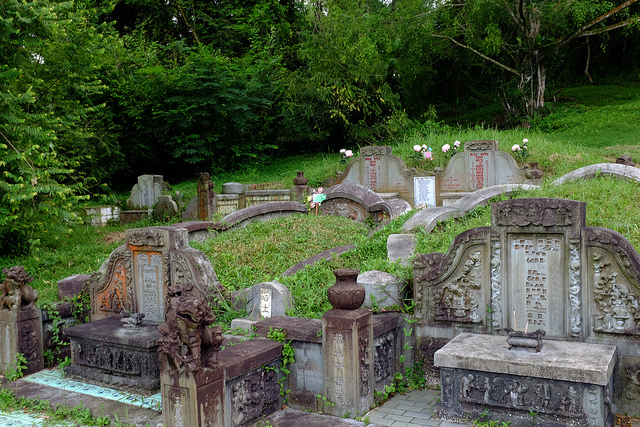
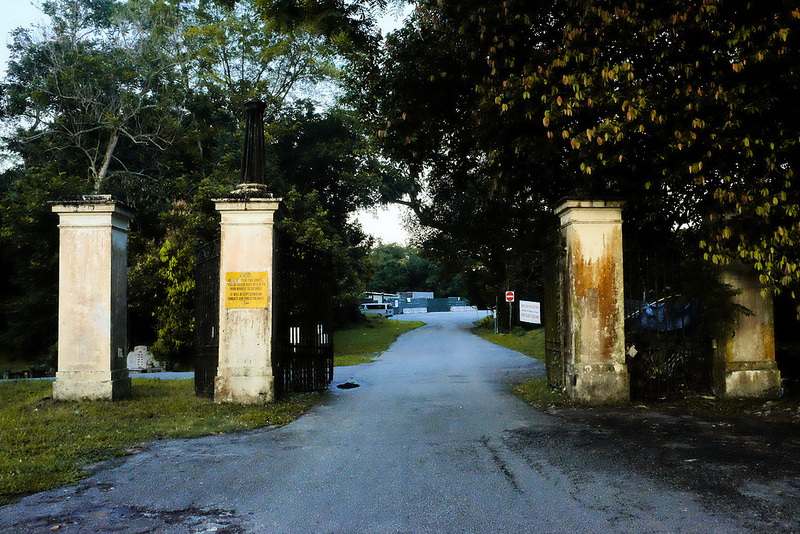
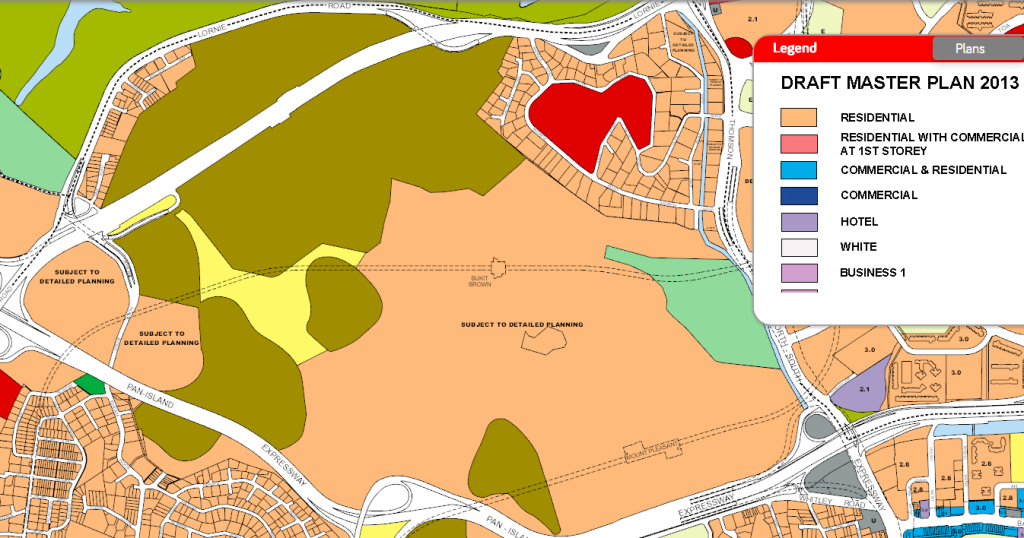
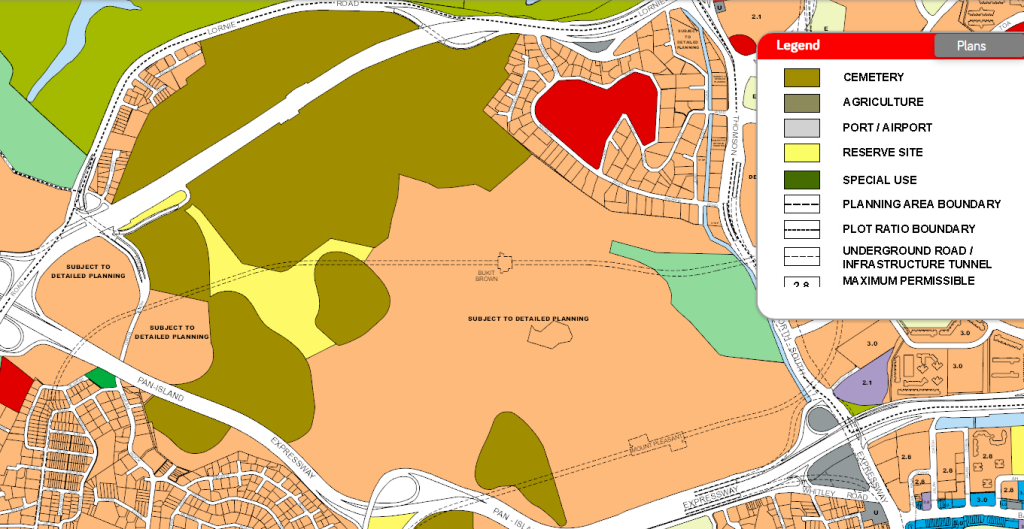
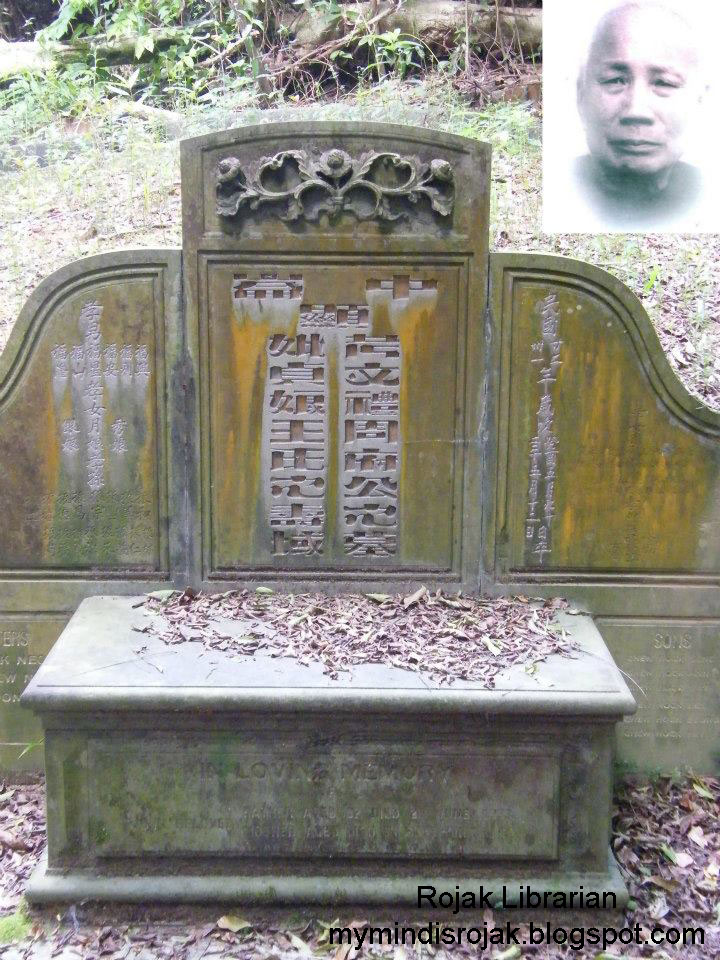

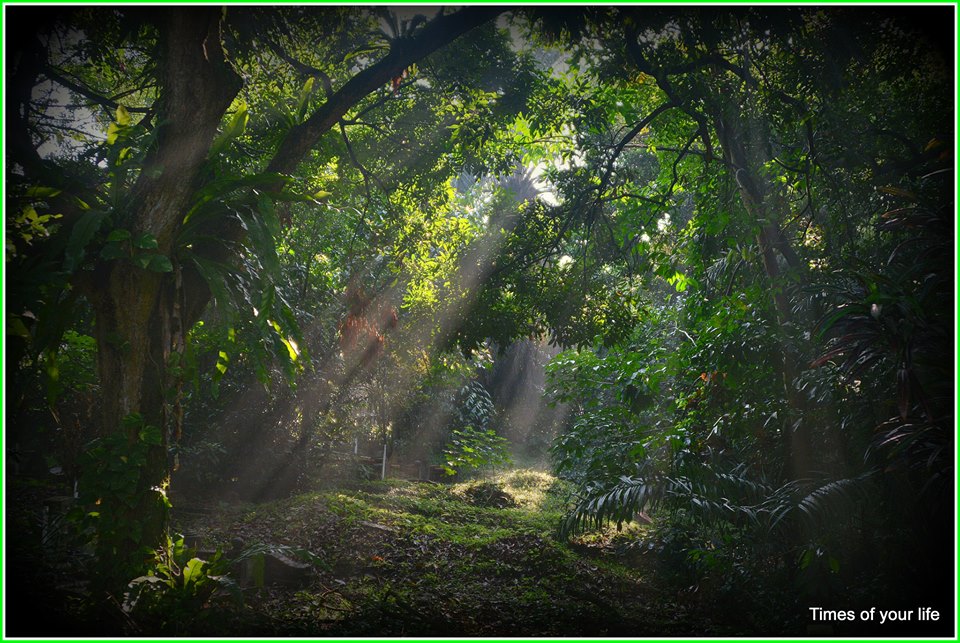
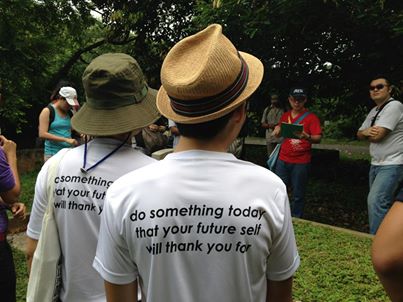
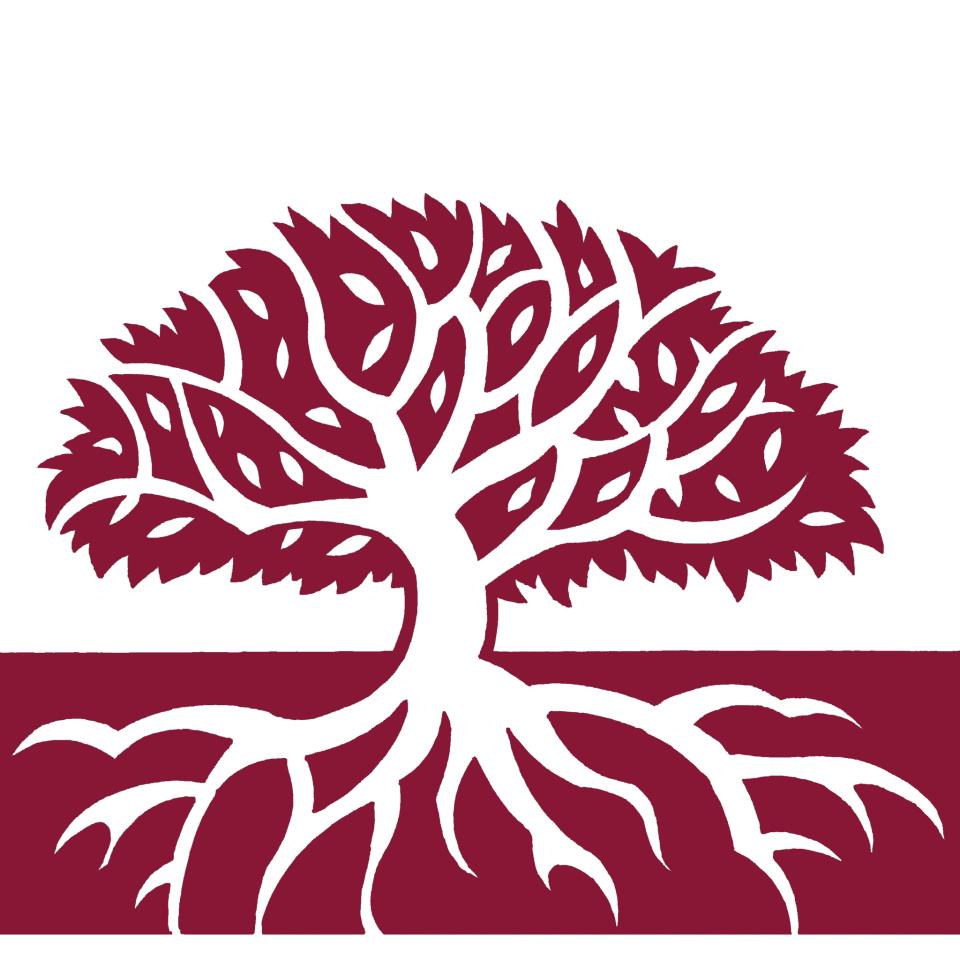
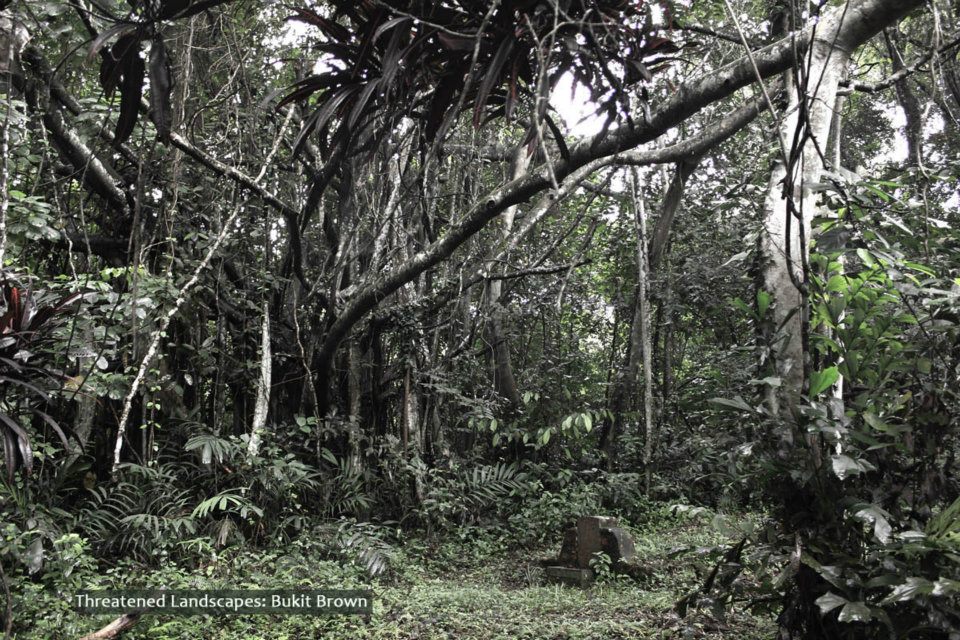
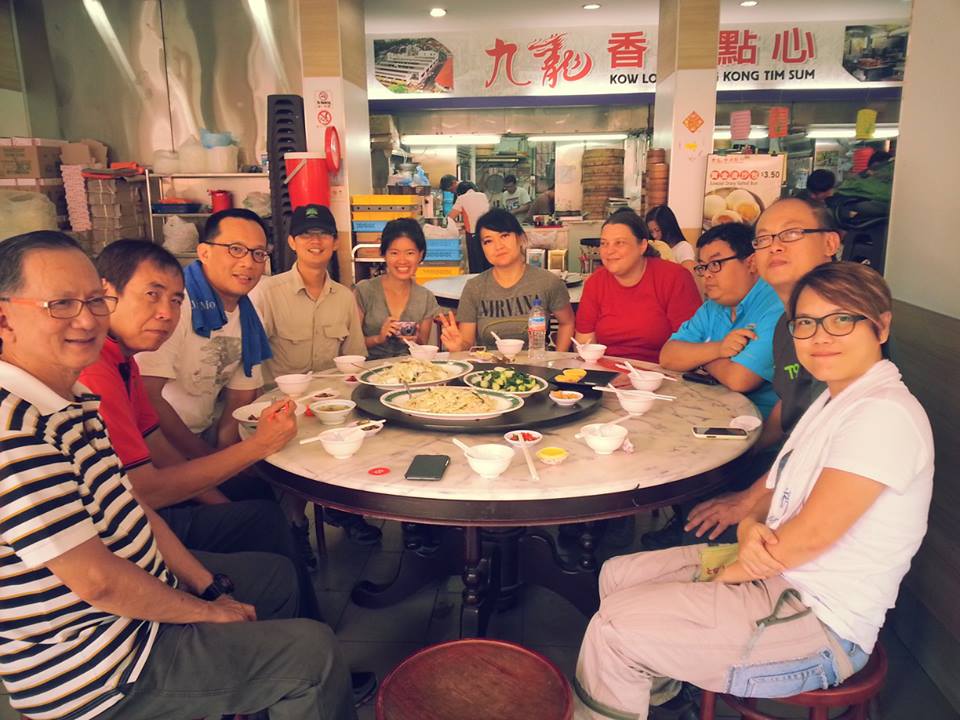





Recent Comments